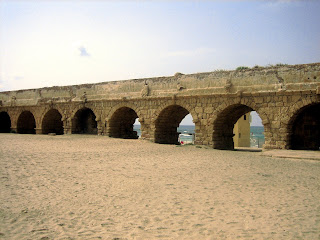.jpg)
This morning we made a quick pit stop at Cana to pick up some pita for lunch before heading to our first site of the day: Sephoris. According to Dr. Wright, Sephoris was “a corridor of Hellenism pushing into Galilee.” Historically, the inhabitants of Sephoris were rich, glamorous, and lived the good life. We examined some beautiful mosaics that told us a lot about their culture. I really enjoyed this because I love art and I think it is fascinating how art reflects a peoples’ worldview. In the synagogue ruins, there is a huge mosaic with Biblical images around the edges, yet in the center there’s a zodiac with the Greek sun god Helios. What’s going on? One possibility is that the Jews compromised and “relaxed” some of the commandments—similar to what the church does today with Sabbath observance. Another possibility is that the zodiac and Helios were simply such accepted cultural symbols that they held no pagan religious connotations for the Jews. Christians today do this all the time; for example, why do we have Christmas trees in our churches? Why do our kids hunt for eggs on Easter? These used to be pagan symbols, but we see no problem using them because they’re part of our culture.
Another mosaic we looked at is often referred to as the “jewel of Galilee,” because it has a depiction of the homeowner’s wife in it. She reminds some of the Mona Lisa. This Byzantine-era mosaic was in a triclinium, an ancient Roman banquet hall. When dining in such a room, everyone lounges on their left side and eats out of communal bowls with their right hand. The host sat at the end of the table, with his “right-hand man” on his right and the guest of honor on his left. Knowing this cultural background gives us a better understanding of the Last Supper. Jesus was the host, sitting in the middle. John, the disciple “whom Jesus loved, was reclining at the table close to Jesus” (Jn. 13:23). The Greek here literally means “in the bosom of Jesus,” which has made many American readers (including myself) rather uncomfortable. However, in Middle-Eastern culture to this day, it is completely normal for members of the same sex to be quite physically close. In both Morocco and Israel, I have seen men walking down the street holding hands, or laying their heads on each other’s shoulders. This verse should not be taken out of cultural context, or else we may totally misunderstand it.
If John was Jesus’ “right-hand man,” which disciple was sitting on the left? In Mark’s account, Jesus tells the disciples, “One of you will betray me, one who is eating with me” (Mk. 14:18). When they begin asking him who it is, he answers, “It is one of the twelve, one who is dipping bread into the dish with me” (14:20). If Jesus is sitting on the end with the bowl in front of him, and John is on his right, then the one who was to betray him must have been sitting on his left in order to reach the same bowl. Judas Iscariot was the guest of honor at the Lord’s Supper. I’m not sure what that means theologically, but it certainly shocked me.
From Sephoris we headed to Jezreel. Since it was raining quite hard, we had most of our lecture on the bus and only went outside to explore the site. We talked about Joseph being sold into slavery and taking the Dothan pass, Ahab’s capital and Jezebel’s palace, Naboth’s vineyard, the importance of the Harod valley and Ramoth-gilead, and Gideon vs. the Midianites.
After that it was storming pretty badly, so we stopped at Beth-Alfa because it had several covered sites with more mosaics. They were found after a kibbutzim started building its community on top of them.
Finally, we made our last stop of the trip at Tel Beth-shan and Scythopolis (one of the Decapolis cities) surrounding it. These were the most impressive ruins we have seen yet! The Greek and Roman influences were overwhelming: multiple cardos, rows of insula, a huge theatre, a public bathhouse, and public lavatories (see picture below for a demonstration of these!)


Jews traveling from comfortably-Jewish Galilee to comfortably-Jewish Jerusalem had two options: either they could go through Samaria, or they could go through Decapolis. Most Jews chose the Decapolis route, avoiding Samaria at all costs. Jesus traveled through both.
As we made our way back “home” to Jerusalem, I reflected on all I’ve learned the past four days. I have new insights into the Bible, Jesus, the Church, culture, and discipleship as a result of our studies in Galilee. I continue to be amazed at all I’m learning and thankful for the opportunity to be here.
























